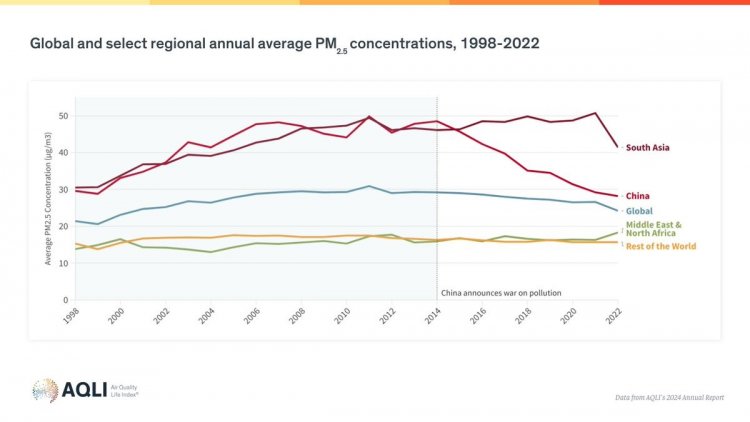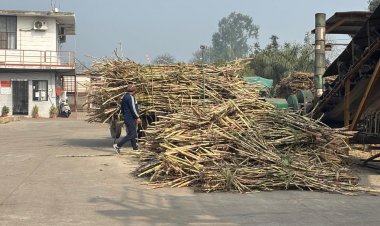Air Pollution Remains the Greatest External Risk to Human Health: AQLI Report
While pollution slightly dipped due largely to a trend reversal in South Asia, more than three-quarters of countries worldwide have not set or aren’t meeting national pollution standards.

Though global pollution was slightly lower in 2022, its burden on life expectancy remains, according to new data from the Air Quality Life Index (AQLI). If the world were to permanently reduce fine particulate pollution (PM2.5) to meet the World Health Organization’s (WHO) guideline, the average person would add 1.9 years onto their life expectancy—or a combined 14.9 billion life-years saved worldwide.
South Asia remains the world’s most polluted region, with residents breathing almost 8.5 times more polluted than the WHO has deemed safe. With the right environmental policies, people living in this region could see 3.5 years added to their lives.
“While air pollution remains a global problem, its largest impacts are concentrated in a relatively small number of countries—cutting lives short several years in some places and even more than 6 years in some regions,” says Michael Greenstone, the Milton Friedman Distinguished Service Professor in Economics and creator of the AQLI along with colleagues at the Energy Policy Institute at the University of Chicago (EPIC).
Global pollution declined in 2022 due almost entirely to a trend reversal in South Asia. While pollution had been on the rise for more than a decade, it declined by 18 percent in one year. While it’s difficult to know for sure the reasons for this decline, meteorological causes—such as above-normal rainfall—likely played a strong role and only time will tell whether policy changes are having an impact.
This data makes clear that particulate pollution is the world’s greatest external risk to human health. Its impact on life expectancy is comparable to that of smoking, more than 4 times that of high alcohol use, more than 5 times that of transport injuries like car crashes, and more than 6 times that of HIV/AIDS. Yet, the pollution challenge worldwide is vastly unequal, with people living in the most polluted places on earth breathing air that is six times more polluted than the air breathed by those living in the least polluted places—and seeing their lives cut short by 2.7 years more because of it.

India Facts
After a decade of experiencing particulate pollution levels averaging at approximately 49 µg/m³—more than nine times the WHO guideline of 5 µg/m³—particulate concentrations in India dropped to 41.4 µg/m³ in 2022 (Figure 1). If these reductions are sustained, an average Indian is likely to live 9 months longer compared to what they would have if they were exposed to levels similar to the last decade. Further, if pollution in India met the WHO guideline, Indian citizens could gain an additional 3.6 years in their life expectancy.
If all of India were to reduce particulate pollution to meet the WHO guideline, residents in Delhi—India’s capital and most populous city— would see the maximum benefits with its residents gaining 7.8 years of life expectancy. In North 24 Parganas—the country’s second most populous district—residents would gain 3.6 years of life expectancy
Countries Fail to Meet Their Standards
National standards are an important tool to set strong policies and improve air quality. These standards—some strong and some weak—reflect the multiple policy goals countries have as they balance economic, environmental and health goals. However, a third of the world’s population lives in regions that don’t meet the standards that their countries have set. If those countries did meet their benchmarks, these 3 billion people would live an average of 1.2 years longer.
“Setting ambitious standards is only one part of the puzzle,” says Tanushree Ganguly, the director of the AQLI. “Equally important is implementing policies and monitoring mechanisms that help enforce these standards. Some countries are succeeding in this, and that gives proof that air pollution is a solvable problem.”
While 37 out of 94 countries with standards aren’t meeting them, more than half of all countries and territories have not set a standard at all. Together, 77 percent of countries and territories worldwide have either not met or do not have a national standard.
Of the countries with no standard, almost none (less than 1 percent) of the governments provide fully open pollution data and two-thirds don’t have any government pollution monitoring. With little data, it is difficult to set pollution standards and enforce them. To help confront this challenge, this year EPIC launched the EPIC Air Quality Fund to support local groups and organizations in installing monitors and providing open data to communities that could benefit the most.
“Highly polluted countries that have little or no air quality data often fall into a bad feedback cycle where having little data leads to little attention or policy investment in the issue which reinforces little demand for data,” says Christa Hasenkopf, the director of the Clean Air Program at EPIC. “Fortunately, there is a massive opportunity to stop this cycle with even a small amount of persistent, open-air quality data. Such data is essential for crafting and reinforcing national standards.”



 Join the RuralVoice whatsapp group
Join the RuralVoice whatsapp group







































